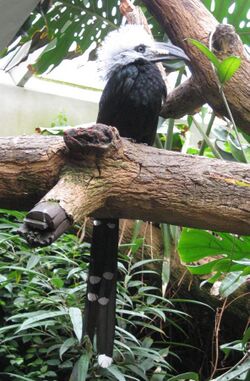Biology:Western long-tailed hornbill
| Western long-tailed hornbill | |
|---|---|

| |
| T. a. albocristatus at Central Park Zoo, USA | |
| Scientific classification | |
| Domain: | Eukaryota |
| Kingdom: | Animalia |
| Phylum: | Chordata |
| Class: | Aves |
| Order: | Bucerotiformes |
| Family: | Bucerotidae |
| Genus: | Horizocerus |
| Species: | H. albocristatus
|
| Binomial name | |
| Horizocerus albocristatus (Cassin, 1848)
| |
| Synonyms | |
|
Buceros albocristatus (protonym)
Tockus albocristatus | |
The western long-tailed hornbill (Horizocerus albocristatus) is a species of hornbill (family Bucerotidae) found in humid forests of West Africa. It was formerly considered to be conspecific with the eastern long-tailed hornbill (Horizocerus cassini) with the English name "white-crested hornbill".
Taxonomy
The western long-tailed hornbill was formally described in 1848 by the American ornithologist John Cassin based on a specimen that had been collected near the Saint Paul River in Liberia. He coined the binomial name Buceros albocristatus.[2][3] The specific epithet combines the Latin albus meaning "white" with cristatus meaning "crested" or "plumed".[4] The species is now placed in the genus Horizocerus that was introduced in 1899 by the American ornithologist Harry C. Oberholser. The western long-tailed hornbill was formerly considered to be conspecific with the eastern long-tailed hornbill (Horizocerus cassini) with the English name "white-crested hornbill".[5]
There are two subspecies,[5] which differ primarily in the amount of white to their head and neck and the presence or absence of white tips to the wing-coverts:
- H. a. albocristatus (Cassin, 1848) – Guinea to west Ivory Coast
- H. a. macrourus (Bonaparte, 1850) – east Ivory Coast to Benin
Distribution and habitat
The western long-tailed hornbill has a large range in West Africa, occurring from southern Sierra Leone, east to Benin including Côte d'Ivoire, Ghana, Guinea, Liberia, and Togo. It is frequent in parts of its range. Although its population is difficult to estimate, it is not thought to be threatened.[1]
Gallery
References
- ↑ 1.0 1.1 BirdLife International (2016). "Horizocerus albocristatus". IUCN Red List of Threatened Species 2016: e.T22725946A94907044. doi:10.2305/IUCN.UK.2016-3.RLTS.T22725946A94907044.en. https://www.iucnredlist.org/species/22725946/94907044. Retrieved 12 November 2021.
- ↑ Cassin, John (1848). "Description of a new Buceros, and a notice of the Buceros elatus, Temm., both of which are in the collection of the Academy of Natural Sciences of Philadelphia". Proceedings of the Academy of Natural Sciences of Philadelphia 3: 331-332. https://www.biodiversitylibrary.org/page/1659227.
- ↑ Peters, James Lee, ed (1945). Check-List of Birds of the World. 5. Cambridge, Massachusetts: Harvard University Press. p. 260. https://www.biodiversitylibrary.org/page/14480271.
- ↑ Jobling, James A. (2010). The Helm Dictionary of Scientific Bird Names. London: Christopher Helm. p. 39. ISBN 978-1-4081-2501-4. https://archive.org/stream/Helm_Dictionary_of_Scientific_Bird_Names_by_James_A._Jobling#page/n39/mode/1up.
- ↑ 5.0 5.1 Gill, Frank; Donsker, David; Rasmussen, Pamela, eds (December 2023). "Mousebirds, Cuckoo Roller, trogons, hoopoes, hornbills". IOC World Bird List Version 14.1. International Ornithologists' Union. https://www.worldbirdnames.org/bow/mousebirds/.
Wikidata ☰ Q27074823 entry
 |





